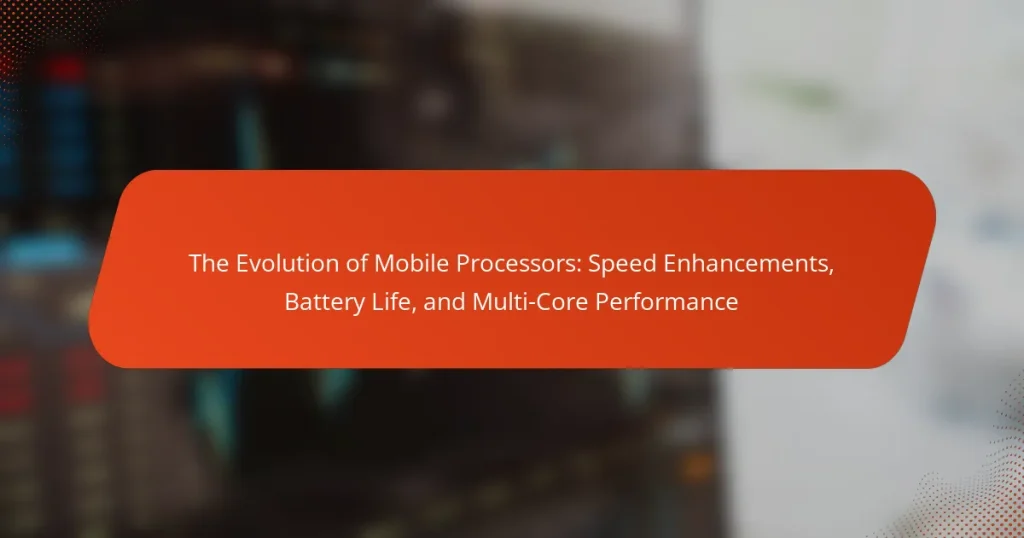Mobile processors are specialized chips that power portable devices such as smartphones and tablets, integrating computing, graphics, and connectivity functions into a single unit. This article examines the evolution of mobile processors, focusing on key advancements in speed enhancements, battery life, and multi-core performance. It highlights how increased clock speeds lead to faster app loading and improved multitasking, while multi-core architectures significantly enhance the ability to handle complex tasks efficiently. The discussion includes examples like Qualcomm Snapdragon and Apple’s A-series processors, emphasizing their role in delivering high performance and energy efficiency in modern mobile computing.

What are Mobile Processors and Why are They Important?
Mobile processors are specialized chips designed to power portable devices like smartphones and tablets. They integrate multiple functions, including computing, graphics, and connectivity, into a single unit. This integration enhances performance while conserving energy, crucial for battery life. Mobile processors enable efficient multitasking and support advanced applications, such as gaming and video streaming. The importance of mobile processors lies in their ability to deliver high performance in compact, energy-efficient designs. For instance, the Qualcomm Snapdragon series and Apple’s A-series processors exemplify advancements that significantly improve speed and efficiency. These processors have evolved to include multi-core architectures, allowing for better performance in demanding tasks.
How have mobile processors evolved over time?
Mobile processors have evolved significantly over time. Initially, mobile processors were single-core with limited processing power. They operated at low clock speeds, typically around 1 GHz. As technology advanced, dual-core processors emerged, enhancing multitasking capabilities. This transition occurred around 2010, with processors reaching speeds of 1.5 GHz.
Subsequently, quad-core processors became standard by 2013, improving performance in graphics and applications. By 2015, mobile processors integrated advanced architectures, such as ARM Cortex-A72, which increased efficiency and speed.
In recent years, octa-core processors have been introduced, allowing for even greater multitasking and performance. Current processors can achieve speeds exceeding 3 GHz, with improved energy efficiency. The introduction of AI capabilities in processors has further enhanced performance across various applications.
Overall, the evolution of mobile processors has focused on increasing speed, enhancing battery life, and improving multi-core performance.
What historical milestones mark the development of mobile processors?
The development of mobile processors has several key historical milestones. In 1993, the first ARM processor, the ARM6, was introduced, enabling efficient mobile computing. In 2005, Apple transitioned to Intel processors, enhancing performance in mobile devices. The introduction of the Qualcomm Snapdragon in 2007 marked a significant advancement, integrating multiple functionalities into a single chip. In 2010, Apple’s A4 chip set a new standard for mobile performance. The launch of the Snapdragon 800 series in 2013 further improved processing power and energy efficiency. In 2017, Apple’s A11 Bionic chip introduced a six-core architecture, optimizing performance for mobile applications. In 2020, the launch of the Apple M1 chip marked a shift towards ARM architecture in laptops, influencing mobile processor design. Each milestone reflects advancements in speed, efficiency, and integration, shaping the mobile computing landscape.
How have technological advancements influenced mobile processor evolution?
Technological advancements have significantly influenced mobile processor evolution by enhancing performance, efficiency, and integration. Innovations in semiconductor technology have led to smaller transistors, allowing for increased processing power within a compact size. For example, the transition from 28nm to 7nm fabrication processes has improved power efficiency and performance, as seen in processors like Apple’s A14 Bionic. Furthermore, advancements in multi-core architecture have enabled better multitasking and improved performance for demanding applications. The introduction of heterogeneous computing, which combines different types of cores, has optimized power consumption and processing speed. Additionally, the integration of AI capabilities into mobile processors has revolutionized tasks like image processing and voice recognition, enhancing user experience. These advancements collectively drive the rapid evolution of mobile processors, making them more powerful and efficient.
What are the key performance metrics of mobile processors?
Key performance metrics of mobile processors include clock speed, core count, thermal design power (TDP), and benchmark scores. Clock speed, measured in GHz, indicates how fast a processor can execute instructions. Core count refers to the number of processing units within the processor, impacting multitasking capabilities. Thermal design power (TDP) signifies the maximum amount of heat generated under load, affecting battery life and device cooling. Benchmark scores, such as those from Geekbench or AnTuTu, provide comparative performance metrics across different processors. These metrics collectively determine a mobile processor’s efficiency, responsiveness, and overall performance in real-world applications.
How is speed measured in mobile processors?
Speed in mobile processors is measured primarily in clock speed, typically expressed in gigahertz (GHz). Clock speed indicates how many cycles a processor can execute per second. Higher clock speeds generally correlate with faster processing capabilities. Additionally, performance benchmarks assess speed through metrics like instructions per cycle (IPC). IPC measures how many instructions a processor can execute in one clock cycle. Popular benchmarking tools include Geekbench and AnTuTu. These tools provide comparative speed ratings across different mobile processors. Overall, a combination of clock speed and IPC gives a comprehensive view of a mobile processor’s speed.
What factors contribute to battery life in mobile processors?
Battery life in mobile processors is influenced by several key factors. These include processor architecture, power management techniques, and manufacturing process. Efficient processor architecture minimizes power consumption during operation. Advanced power management techniques dynamically adjust performance based on workload, reducing energy usage. The manufacturing process, such as using smaller transistors, enhances energy efficiency. For instance, processors built on a 7nm process consume less power compared to those on a 14nm process. Additionally, clock speed impacts battery life; higher speeds typically lead to increased energy draw. Overall, these factors collectively determine the overall battery performance of mobile devices.
What is multi-core performance and why does it matter?
Multi-core performance refers to the capability of a processor to execute multiple tasks simultaneously using multiple cores. This performance is crucial for modern computing as it allows for improved multitasking and faster processing of complex applications. For instance, tasks such as video editing, gaming, and data analysis benefit significantly from multi-core architecture. Research shows that multi-core processors can deliver performance improvements of up to 50% compared to single-core processors in multi-threaded applications. This enhancement leads to a smoother user experience and more efficient resource utilization in mobile devices.

How do Speed Enhancements Impact Mobile Processor Performance?
Speed enhancements significantly improve mobile processor performance. They increase clock speeds, allowing processors to execute more instructions per second. This results in faster app loading times and smoother multitasking. Enhanced speeds also enable better handling of complex tasks like gaming and video editing. According to benchmarks, processors with speed enhancements can show up to 30% performance gains in real-world applications. Additionally, higher speeds can lead to increased power consumption, requiring better thermal management. Thus, while speed enhancements boost performance, they also necessitate advancements in cooling technologies to maintain efficiency.
What are the latest speed enhancement technologies in mobile processors?
The latest speed enhancement technologies in mobile processors include advanced manufacturing processes, improved architecture designs, and AI integration. Advanced manufacturing processes, such as 5nm and 3nm nodes, allow for more transistors on a chip, increasing performance and efficiency. Improved architecture designs, like ARM’s Cortex-X series, focus on maximizing single-threaded performance. AI integration enhances processing speed by optimizing tasks in real-time. For instance, Qualcomm’s Snapdragon 8 Gen 2 features an AI engine that boosts performance for specific applications. These technologies collectively contribute to faster processing speeds and better overall performance in mobile devices.
How do clock speeds affect overall performance?
Clock speeds directly influence overall performance in processors. Higher clock speeds generally lead to faster data processing. This results in quicker execution of tasks and improved responsiveness. For example, a processor running at 3.0 GHz can perform tasks faster than one at 2.0 GHz. However, clock speed is not the sole factor in performance. Other elements, such as architecture and core count, also play significant roles. Benchmarks show that processors with higher clock speeds often achieve better performance scores in applications. Thus, while clock speed is a critical factor, it must be evaluated alongside other specifications for a comprehensive performance assessment.
What role does architecture play in speed enhancements?
Architecture plays a critical role in speed enhancements by determining how efficiently a processor executes instructions. It influences the design of data pathways, cache structures, and execution units. Efficient architecture minimizes latency and maximizes throughput. For instance, advanced architectures like ARM’s big.LITTLE allow for dynamic performance scaling. This design enables processors to switch between high-performance cores and energy-efficient cores based on workload demands. Studies show that optimized architectures can lead to performance improvements of up to 50% in specific tasks. Additionally, architectural innovations such as pipelining and superscalar execution enhance instruction processing rates. Thus, architecture is fundamental in driving the speed capabilities of mobile processors.
Why is battery life crucial for mobile processors?
Battery life is crucial for mobile processors because it directly impacts device usability. A mobile processor’s performance is limited by the power it consumes. Efficient battery life allows devices to run longer without frequent recharging. High-performance processors demand more power, which can drain batteries quickly. For instance, a smartphone with a powerful processor may need a battery capacity of at least 4000 mAh to sustain daily use. Users expect their devices to last throughout the day, making battery life a key consideration. Additionally, advancements in processor technology aim to enhance performance while minimizing energy consumption. This balance is essential for user satisfaction and device functionality.
What innovations have improved battery efficiency in mobile processors?
Innovations that have improved battery efficiency in mobile processors include advanced semiconductor materials, dynamic voltage and frequency scaling (DVFS), and improved power management techniques. Advanced semiconductor materials, such as FinFET technology, reduce power leakage and increase efficiency. DVFS allows processors to adjust their voltage and frequency according to workload demands, minimizing energy consumption during low-intensity tasks. Improved power management techniques, including the use of dedicated low-power cores, help optimize energy use without sacrificing performance. These innovations collectively contribute to longer battery life in mobile devices.
How does power consumption relate to processor performance?
Power consumption directly impacts processor performance. Higher power consumption typically allows for increased performance levels. Processors draw more power to execute complex tasks and higher clock speeds. This results in faster data processing and improved multitasking capabilities. However, excessive power consumption can lead to overheating and reduced efficiency. Efficient power management is crucial for sustaining performance without compromising battery life. Studies show that modern processors use dynamic voltage and frequency scaling to optimize power usage. This technique balances performance needs with energy efficiency. Thus, power consumption and processor performance are closely intertwined, influencing overall device functionality.

What is the Role of Multi-Core Performance in Mobile Processors?
Multi-core performance in mobile processors enhances multitasking capabilities and overall efficiency. It allows multiple tasks to be processed simultaneously, improving user experience. For instance, running apps, browsing the web, and streaming videos can occur without lag. This performance is crucial as mobile applications become more complex and resource-intensive. According to a report by IDC, multi-core processors can improve performance by up to 80% compared to single-core counterparts. This advancement leads to smoother operation and better battery management in devices. Thus, multi-core performance is essential for modern mobile computing.
How do multi-core processors differ from single-core processors?
Multi-core processors contain multiple processing units, while single-core processors have only one. This difference allows multi-core processors to handle multiple tasks simultaneously. As a result, they can significantly improve performance in multi-threaded applications. Multi-core processors can execute more instructions per clock cycle compared to single-core processors. For instance, a dual-core processor can effectively double the processing capability of a single-core processor under optimal conditions. This architecture also enhances energy efficiency, as multi-core processors can distribute workloads, reducing power consumption during high-demand tasks. The advancement in multi-core technology reflects the growing need for higher performance in computing devices.
What advantages do multi-core processors offer to users?
Multi-core processors provide significant advantages to users, primarily through enhanced multitasking capabilities. They allow multiple processes to run simultaneously, improving overall system performance. This capability leads to faster application loading times and smoother operation during demanding tasks. For instance, video editing software benefits greatly from multi-core architecture, as it can utilize several cores to process tasks concurrently. Additionally, multi-core processors can improve energy efficiency by distributing workloads across cores, reducing power consumption during less intensive tasks. Studies show that devices with multi-core processors exhibit better performance benchmarks compared to single-core counterparts. Overall, these processors enhance user experience in both everyday applications and resource-intensive programs.
How does software optimization impact multi-core performance?
Software optimization significantly enhances multi-core performance. It improves the efficiency of resource utilization across multiple cores. Optimized software can distribute tasks evenly among cores. This reduces bottlenecks and increases processing speed. Additionally, optimization techniques like parallel processing allow simultaneous execution of tasks. Studies show that well-optimized applications can achieve performance gains of 30% or more on multi-core systems. Effective memory management also plays a crucial role in optimizing multi-core performance. By minimizing memory access delays, software ensures faster data processing across cores.
What are the challenges faced in mobile processor development?
Mobile processor development faces several significant challenges. One major challenge is power efficiency. Mobile devices require processors that consume less power while maintaining performance. Thermal management is another critical issue. High performance can lead to overheating, which affects device longevity. Additionally, miniaturization poses challenges for integrating more transistors into smaller spaces. This can result in increased complexity in design and manufacturing. Another challenge is balancing performance and battery life. Users demand faster processors without sacrificing battery duration. Lastly, software optimization is crucial. Mobile applications must be designed to leverage the capabilities of advanced processors effectively.
How do thermal management issues affect performance?
Thermal management issues negatively impact performance in mobile processors. Excessive heat can lead to thermal throttling, which reduces processing speed to prevent damage. This throttling results in slower application performance and longer load times. Additionally, high temperatures can shorten the lifespan of components. Efficient thermal management ensures optimal performance and energy efficiency. Studies show that processors operating at lower temperatures maintain higher performance levels. For instance, maintaining a temperature below 85°C can enhance performance by up to 20%.
What are the limitations of current mobile processor technology?
Current mobile processor technology faces several limitations. These include thermal management challenges, which can lead to overheating during intensive tasks. Battery life is often constrained by the power demands of high-performance processors. Additionally, mobile processors typically have less computational power compared to their desktop counterparts. Limited physical space in mobile devices restricts cooling solutions and component size. Integration of more features can lead to increased complexity and potential reliability issues. Furthermore, advancements in AI and machine learning require more processing power, straining current mobile architectures. Compatibility with legacy software can also hinder performance optimization. Lastly, the rapid pace of technology evolution can make existing processors obsolete quickly.
What tips can users follow to maximize mobile processor performance?
To maximize mobile processor performance, users should regularly update their device’s operating system. Updates often include performance enhancements and bug fixes. Users should also close unused apps running in the background. Background apps consume processing power and memory. Reducing screen brightness can help save battery life, indirectly benefiting processor performance. Users should avoid using live wallpapers and widgets that require constant updates. These can strain the processor and drain battery. Clearing cache and unnecessary files regularly can free up resources for better performance. Finally, users should consider disabling or uninstalling apps that are not frequently used. This minimizes the load on the processor and optimizes overall device efficiency.
The main entity of the article is mobile processors, which are specialized chips that power portable devices such as smartphones and tablets. The article examines the evolution of mobile processors, highlighting advancements in speed, battery life, and multi-core performance. Key topics covered include the historical milestones in mobile processor development, the impact of technological advancements on performance and efficiency, and the significance of multi-core architecture for multitasking. Additionally, it addresses the relationship between clock speed, power consumption, and battery life, as well as the challenges faced in mobile processor development and tips for users to optimize performance.




